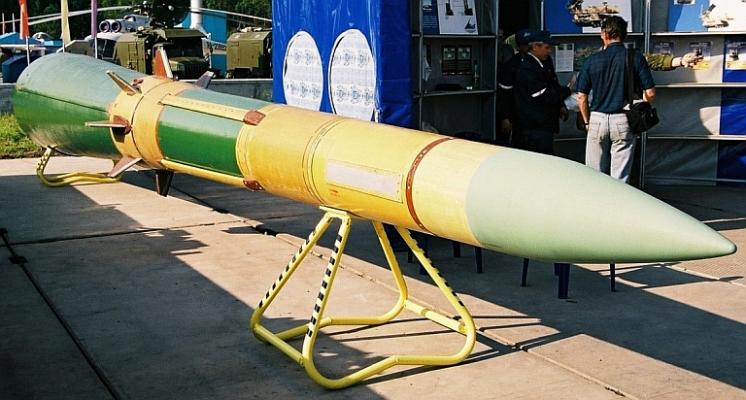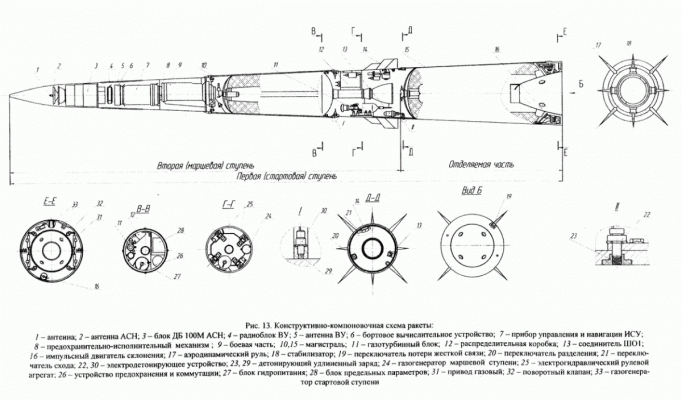Anti-aircraft guided missile (ALCM) 9M83 is designed to destroy aircraft in the conditions of intensive radio resistance (including maneuvering with overloads up to 7-8g), cruise missiles (including low-flying type ALCM), and ballistic missiles (BR) type 8K14 and "Lance". ZUR 9M82 - also for the destruction of the head units of missiles "Pershing-1A", "Pershing-1B", aircraft BR type SRAM, aircraft active interference at ranges up to 100 km.
ZUR 9M82 and 9M83 (see diagram, photo) are two-stage solid-fuel missiles, made by the aerodynamic scheme "carrying cone" with gas-dynamic controls of the first stage. The design of the rockets is unified to the maximum extent possible, the main differences being the application of a more powerful launch stage on ZUR 9M82.
The LSDs are equipped with a shrapnel-fluid directional BC. The tail compartment of the launch stage accommodates four aerodynamic rudders and four stabilisers. The 9M82 and 9M83 missiles are operated in transport and launch containers 9Y238 and 9Y240. The missiles can be operated in the military for at least 10 years without inspection or maintenance.
The main part of the missiles accommodates single on-board equipment units for the missiles:
- homing equipment;
- non-contact fuse device (NLD);
- inertial control system;
- on-board computer device.
The SSD is launched in the vertical position of the TPC by means of a powder pressure accumulator located in it. After the rocket leaves the transport and launch container at vertical launch, the process of declination of the rocket at a given angle begins (by using several of the eight impulse engines), which is completed by the time the launch stage is over. At launches in the far zone for aerodynamic purposes, the launch of the marching stage engine is performed with a delay of up to 20 seconds in relation to the time when the launch stage engine is completed.
Control of the rocket on the march and passive flight areas is carried out by deflecting four aerodynamic rudders. The LSD is aimed at the target either by a proportional navigation inertial control system with a switch to homing approximately 10 seconds before approaching the target, or by a command-inertial control system with homing during the last 3 seconds of the flight. The latter method of homing is used when shooting at targets under conditions of powerful relayed (response) interference of the external cover. The SAM flight under inertial control is carried out by energetically optimal trajectories, which provides extremely high reach of the missiles.
The flight task is entered into the onboard LSD computer with a special computer and is corrected in flight by radio commands received by homing equipment from the PU transmitter. Optimal selection of the transition commands to homing is carried out on the information from the homing equipment and the inertial control system of 9M82 missile, makes it possible to hit this SAM of such small targets, such as the head units of the ballistic missile "Pershing-1A" and aircraft ballistic missile SRAM.
New 9M82M and 9M83M missiles are used in the Antey-2500 SAM system. They have a much longer range (up to 200 km), higher effectiveness in hitting all types of tactical and operational-tactical ballistic and aeroballistic missiles. At the same time, the maneuverability characteristics of 9M82M and 9M83M missiles (available overload up to 30g) are significantly increased, which allows to hit intensively maneuvering targets. The maximum flight speed of 9M82M ZUR is 2600m/sec, 9M83M - 1700m/sec.
Composition
The main elements of 9M83 rocket are glider, engines (impulse declination, launch, marching), gas-hydraulic systems, electrical equipment, liquidation system, combat unit, onboard equipment.
The rocket consists of the second (marching) stage and a detached part (a launch stage) a launch stage provides dispersal of a marching stage to speed about 1200 m/s, carrying out simultaneously declination (turn) of rocket in a plane of a bias on the corner providing flight of rocket on an optimum trajectory to the set point of a zone beginning from which after separation of a launch stage there is a rocket guidance. The second (marching) stage of the missile delivers the warhead of the missile to the singing area.
For ease of manufacture and installation, the missile body is divided into eight compartments.
In the first, head, compartment placed the antenna of the explosive device mounted on an antenna block of homing equipment.
In the second compartment the radio block of an explosive device with the aerial, an onboard computing device, a control and navigation device of inertial control system are placed.
The third compartment accommodates a directional combat unit and a safety executive mechanism.
The fourth compartment is an engine of the second stage (marching - MD). It settles down in the central part of a marching stage for the purpose of maintenance of comprehensible positions of the center of masses on all sites of a flight path of a rocket, and also normal functioning of onboard equipment at considerable vibrating and power loading.
In a tail part of a flight stage (the fifth and sixth compartments) the gas-turbine block of a turbo-generator source of a power supply, gas-hydraulic system of a flight stage consisting of the gas generator (GGM) and the block of a hydraulic power supply, electrohydraulic steering units, connectors Ш01 and Ш02, switches of descent (PKS) and the switch of division (ПКР) are located. There is also a system of emergency liquidation, consisting of a block of limit parameters (BPP), protection and switching device (PKS), two liquidation detonating elongated charges (ELD) with universal electrodetonators (UED) and separation system, consisting of detonating elongated charge and universal electrodetonator.
Electrical communication between the onboard equipment units and the equipment of the head and tail parts of the marching stage is carried out through the highways passing on the outer surface of the marching engine.
Four aerodynamic rudders and four stabilizers are located on the hull surface of the sixth compartment.
The seventh and eighth compartments form a detachable block of the rocket's launch stage. It consists of the launch engine (compartment seven) and the tail compartment (compartment eight), which covers the engine tail block.
Electrical communication between the equipment of the launch and marching stages is carried out through a trunk passing on the outer surface of the DS. Complex of compartments 1-8 forms the rocket case representing a cone with the sharpened forward part. The compartments are connected to each other by means of studs. The nut sockets at the compartments' joints are closed with special plugs or band clamps. Compartments 1-6 are heat-resistant and 7.8 are painted.
The rocket in the container is fixed axially by two locks, in the radial direction it is held in the front part of the container by four folding supports, and in the rear part by a support belt at the end of the tail compartment. The missile and the container are electrically connected via a breakaway connector Sh01.
Tactical and technical characteristics
| Name | 9М83 | 9М82 |
| Length,mm | 7898(8570) | 9913(10525) |
| Maximum diameter,mm | 915(930) | 1215(1460) |
| Weight, kg | 3500(3600) | 5800(6000) |
| Weight of BC,kg | 150 | |
| Flight Speed, m/sec. | 1200 | 1800 |
| Maximum overheating, units | 20 | 20 |
| Boundaries of the effective zone, km - remote - top - near - bottom |
72 25 6 0.025 |
100 30 13 1 |
| Potential range of target GSN capture with EPR 0.05m2 | 30 | 30 |
| Technical data of 9M83 missile | |
| Type of Missiles | Controlled two-stage |
| Aerodynamic scheme of the rocket | Carrier cone |
| Type of start | From the COD using a powder pressure accumulator |
| Angle of elevation, deg. | 90 ±5 |
| Control System | Initial plus homing or command-inertial plus homing |
| Starter and march engines | Solid fuel |
| Start engine running time, s | 5,05 |
| Operating time of the marshal engine, s | 13.86 |
| Mass of the rocket with TPC, kg | 2980 |
| Missile launch weight, kg | 2290 |
| Second foot weight, kg | 1213 |
| Weight of combat unit, kg | 150 |
| Rocket length (from theoretical to sock to cut the launch engine nozzle), mm | 7900 |
| Maximum missile diameter, mm | 915 |
| Steering wheel swing in working position, mm | 1200 |
| Container type | Transport and launch |
| Maximum pressure in TIC at start, MPa | 1,3 |
| TPC lid opening time, s | 0,5 |
| Overall dimensions of TPK, mm: - length - width - altitude |
8560 1000 1080 |
| TPC weight, kg | 690 |

